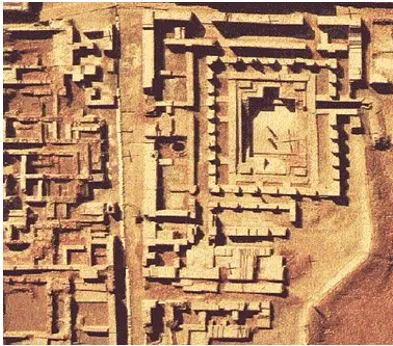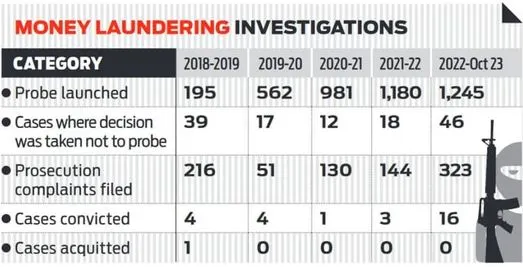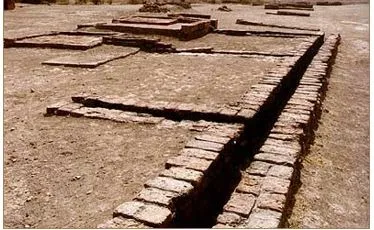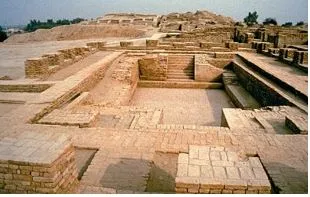

20th September 2024 (8 Topics)
Mains Issues
Context
On September 20, 2024, the centenary of John Marshall’s groundbreaking article in The Illustrated London News is being observed. Marshall, then-Director General of the Archaeological Survey of India (ASI), announced the discovery of the Indus Valley civilization, now known as the Harappan civilization. This event has significant historical implications, as it revealed a sophisticated urban culture in South Asia that existed around 2500 BCE, reshaping understandings of ancient history.
About Harappan Civilization
- The Harappan civilization, also known as the Indus Valley civilization, flourished during the Bronze Age, approximately from 3300 BCE to 1300 BCE.
- Early Harappan: 3300–2600 BCE
- Mature Harappan: 2600–1900 BCE
- Late Harappan: 1900–1300 BCE
- Other important Civilizations:Egyptian (7000BC to 3000BC) and Mesopotamian (6500BC to 3100BC) civilizations.
- It is characterized by advanced urban planning, agricultural practices, and trade networks.
- The civilization was technologically sophisticated, exhibiting expertise in various fields including metallurgy, ceramics, and hydraulic engineering.
- The name "Harappan" derives from the archaeological site of Harappa, one of the first sites to be discovered in modern-day Pakistan.
- Key features of the civilization include:
- Urban Planning: Cities like Harappa and Mohenjo-daro featured grid patterns, advanced drainage systems, and standardized fired-brick construction.
- Economy and Trade: The civilization engaged in extensive trade with regions such as Mesopotamia, evidenced by found seals and artifacts.
- Script and Art: The Harappans developed a writing system (Indus script), and their artisans created intricate seals, pottery, and jewelry.

Architectural features (Mohenjodaro)
Town Planning
- The city showcases a well-planned large-scale town layout.
- Division of the City: Mohenjodaro was divided into two main parts: the Citadel and the Lower Town.
- Citadel: Constructed on mud brick platforms, it was walled and likely served special public purposes.
- Lower Town: Also walled, built on a raised platform, indicating a systematic approach to construction.
- Uniform Bricks: The buildings were made from uniformly sized bricks.
- Grid Pattern Streets: The roads and streets were laid out in a grid pattern, intersecting at right angles.
- Residential Buildings: The Lower Town featured residential buildings, typically centered around a courtyard.
- Privacy Features: Ground floor walls lacked windows, ensuring privacy; entrances did not directly expose the courtyard.
- Bathrooms and Drains: Every house had a brick-paved bathroom connected to street drains. Many houses also had staircases leading to upper levels.
Drainage System
- A well-designed drainage system was a hallmark of Harappan cities. Every house was connected to street drains made of mortar, lime, and gypsum.
- Cleanable Drains: Drains were covered with large bricks for easy lifting and maintenance.
- Sewage Pits: Pits were located on either side of the streets for sewage management.
- Long Channels: Long drainage channels with sumps for cleaning were constructed at intervals.
- Smaller Settlements: In places like Lothal, houses were made of mud bricks, and the drains used burnt bricks.
The Great Bath
- The Great Bath is one of the special buildings located on the citadel. It was used for religious ceremonies or public gatherings.
- Design: A large rectangular tank surrounded by corridors, with steps leading into the tank from the north and south. The tank was made watertight using mortar and gypsum.
- Connected Rooms: Rooms flanked the tank, one of which housed a large well, with water flowing into a massive drain
Key Excavations, Locations, Findings
- Mohenjo-daro, Harappa, Ganweriwala (all now in Pakistan), Rakhigarhi, and Dholavira(both in India) are the five biggest Harappan sites out of about 2,000 sites in the civilisational area, which is spread over 1.5 million sq.km. in India, Pakistan, and Afghanistan.
- There are about 1,500 sites in northwestern India, including in Gujarat, Haryana, Jammu and Kashmir, Maharashtra, Rajasthan, and Uttar Pradesh.
- The village of Daimabad on the banks of the Godavari river in Maharashtra is the southernmost outpost of the Harappan civilisation.
- There are about 500 sites in Pakistan, and a few in Afghanistan.
- The civilisation burgeoned on the banks of the Indus and Saraswati rivers, the latter of which is believed to have dried up circa 1900 BCE.
|
Harappa
|
|
|
Mohenjo-daro
|
|
|
Dholavira |
|
|
Rakhigarhi
|
|
|
Ganweriwala
|
|
|
Mehrgarh
|
|
Decline of Harappan Civilization
- Climatic Change could have affected agricultural productivity and water supply.
- Deforestation may have led to soil erosion and reduced agricultural output.
- Excessive Floods could have devastated settlements and agricultural lands.
- Unsustainable agricultural practices may have depleted resources and affected the ecosystem.
- Shifting or Drying Up of Rivers could have severely impacted water availability.
- The arrival of outside groups, possibly including the Aryans, might have contributed to the decline.
- A marked decline in distinctive artifacts, such as seals and pottery, suggests a breakdown in the civilization’s cultural practices.


Mains Issues
Context
As per a report by the Financial Action Task Force (FATF), India has employed an effective system that has improved anti-money laundering (AML) and tackled counter-terrorist financing over the past 5 years, but there is room for improvement in aspects such as long pendency of trials and shortcoming in assessment of money laundering risks emanating from offences such as human trafficking.
Key Findings
- Progress in AML/CFT Framework
- India’s AML/CFT framework shows good results in risk understanding, access to beneficial ownership information, and asset deprivation from criminals.
- Authorities effectively utilize financial intelligence and cooperate well domestically and internationally.
- Economic and Risk Landscape
- As a lower-middle-income country with the world’s fifth-largest economy, India faces significant money laundering risks from fraud, corruption, and drug trafficking.
- India confronts serious threats from terrorist groups like ISIL and Al Qaeda, necessitating improved prosecution and sanctions for terrorist financiers.
- Financial Inclusion and Transparency
- Increased Bank Access: India has significantly boosted financial inclusion, with more citizens gaining access to bank accounts and digital payment systems.
- Financial Sector Understanding: There is a strong understanding of risks in the financial sector, particularly among commercial banks, although smaller institutions require further development.
- Areas for Improvement
- Court Backlog: A significant backlog of pending money laundering cases hampers progress in prosecution.
- The number of investigations has been increasing but the number of prosecution complaints has not kept pace. To increase the rate of conviction,
- Enforcement Directorate has made non-conviction based seizures to the tune of Rs 16,497 crore from FY19 to FY23, while confiscations based on convictions were worth Rs 39 crore. During the five-year period, the ED started 4,163 investigations, of which 28 cases ended in conviction. In 132 cases, the ED decided to not probe further.
What is Money Laundering?
- Money laundering is the process of transforming proceeds from criminal activities to disguise their illegal origin. This allows criminals to enjoy their profits without attracting attention to the underlying illicit activities
- Common Sources of Criminal Proceeds
- Illegal Activities: Arms sales, drug trafficking, smuggling, and organized crime (e.g., prostitution rings).
- Financial Crimes: Embezzlement, insider trading, bribery, and computer fraud.
- Objectives of Money Laundering: Criminals aim to control their funds while minimizing attention to their illegal activities. They achieve this by:
- Disguising the sources of funds
- Changing the form of the money
- Moving funds to jurisdictions where they are less likely to attract scrutiny
- Authorities investigate and prosecute anti-money laundering offences in India?
- The Directorate of Enforcement (ED): Directorate of Enforcement (ED) is the principal legal entity in charge of looking into and prosecuting money laundering offences under the PMLA.
- ED comes under the Department of Revenue within the Ministry of Finance.
- Financial Intelligence Unit – India (FIU-IND):I is a part of the Department of Revenue and Ministry of Finance. It is the primary national body in charge of collecting, processing, assessing, and disseminating data about suspicious financial transactions to law enforcement authorities and foreign FIUs.
- Others:
- Economic Offences Wing
- Central Bureau of Investigation (CBI)
- Income Tax Department
- Registrar of Companies (RoC)
- Regulators (Reserve Bank of India (RBI), Securities & Exchange Board of India (SEBI), and Insurance Regulatory & Development Authority of India (IRDAI))
- The Directorate of Enforcement (ED): Directorate of Enforcement (ED) is the principal legal entity in charge of looking into and prosecuting money laundering offences under the PMLA.
Anti-Money Laundering Laws
- The international community has established the Financial Action Task Force (FATF) in 1989, an intergovernmental organisation that sets international standards to combat money laundering and terrorist financing.
- As part of its mandate, the FATF issued 40 recommendations, providing a framework for countries to prevent and combat these financial crimes.
- India became the 36th member of the watchdog in 2010.
- In response to this international obligation, India enacted as the Prevention of Money Laundering Act (PMLA) in 2002 (under Article 253).
- The core objective of the PMLA is to address the laundering of illicit funds generated through activities such as drug trafficking.
- By targeting the flow of illegal proceeds, the legislation aims to protect the financial infrastructure of the country.

Initiatives by the Indian government against money laundering
|


Mains Issues
Context
The Central government's decision to designate the environmentally significant Galathea Bay as a 'Major Port' under the Great Nicobar Island Development Project raises serious concerns. Central to this situation is the Environmental Impact Assessment (EIA), which is intended to safeguard against ecological harm, however, got overlooked by the Ministry of Environment, Forest and Climate Change (MoEFCC).
What is Environmental Impact Assessment (EIA)?
- Environmental Impact Assessment (EIA) is a systematic process that evaluates the potential environmental effects of proposed projects or developments before they are approved.
- It aims to balance economic growth with environmental protection, particularly in developing countries like India, where there are challenges of environmental degradation and climate change.
- Objectives of EIA
- Evaluate Impacts: To assess both positive and negative environmental, economic, and social impacts of development projects.
- Informed Decision-Making: To provide detailed analysis to aid decision-makers.
- Promote Sustainable Development: To identify potential negative effects early in the planning stage and suggest alternatives and mitigation measures.
- Public Participation: To engage local communities and stakeholders through consultations, allowing them to voice concerns.
Evolution of EIA in India
- EIA was first established in the US in 1969. India started its EIA process in 1978-79, focusing initially on large infrastructure projects like dams and power plants.
- Legal Framework: The Environment (Protection) Act of 1986 made EIA mandatory for large projects. The first EIA norms were notified in 1994, requiring all development projects to undergo the EIA process for prior environmental clearance.
- The 1994 EIA notification was revised in 2006, and again in 2020 to make the process more transparent and efficient.
- Steps Involved in EIA
- Screening determines if a project needs an EIA based on size and potential impacts.
- Scoping identifies possible environmental impacts, viable alternatives, and mitigation measures.
- Public Consultation allows local communities and stakeholders to express their concerns.
- Authorities review the EIA report to decide on project approval, rejection, or conditional approval.
EIA Process in India
Projects are classified into two main categories based on their potential environmental impacts:
- Category A: Requires prior clearance from the Central Government based on recommendations from an Expert Appraisal Committee (EAC).
- Category B: Requires clearance from the State Environment Impact Assessment Authority (SEIAA) based on recommendations from a State Expert Appraisal Committee (SEAC). Category B projects are further divided into:
- B1: Requires a full EIA report.
- B2: Exempt from EIA requirements.
Supreme Court Observations
The Supreme Court of India has emphasized the importance of the EIA process:
- In TN Godavarman Thirumulpad v Union of India (1997), the Court recognized the right to a clean environment and the need for EIA before starting projects in forest areas.
- In MC Mehta v Union of India (1996), the Court stressed the necessity of EIAs for projects affecting water bodies.
- In Centre for Environmental Law v Union of India (2018), the Court reiterated the importance of EIA procedures and public consultations.
Government Initiatives
- ENVIS (Environmental Information System): Established in 1982 to collect and disseminate environmental information, aiding decision-making.
- PARIVESH: A single-window platform launched for efficient environmental clearance processes and compliance monitoring.
Suggestive Measures
India aims to balance economic development with environmental sustainability. Key recommendations for improving the EIA process include:
- Reducing Delays: Addressing the average delay of 238 days in granting environmental clearances.
- Strengthening Public Engagement: Extending public consultation periods and providing information in local languages.
- Independent EIA Authority: Considering the establishment of an independent authority for more effective decision-making.
- Standalone EIA Law: Exploring the possibility of a separate law for EIA to enhance governance.


Prelims Articles
Context
Kerala has recently faced a worrying surge in cases of amoebic meningoencephalitis, particularly affecting young children during the summer months.
Amoebic Meningoencephalitis
- Amebic encephalitis is a rare but lethal central nervous system
- It is caused by free-living amoebae (FLA) found in freshwater bodies.
- There are 2 types of amebic encephalitis, namely primary meningoencephalitis and granulomatous amebic encephalitis (GAE).
- Primary Amoebic Meningoencephalitis (PAM): It is most commonly caused by Naegleria fowleri, this infection attacks brain tissue, leading to severe swelling and a high fatality rate, typically between 97% and 100%. Initial symptoms resemble those of bacterial meningitis, complicating timely diagnosis.
- Granulomatous Amoebic Encephalitis (GAE): It is caused by other amoebae like Acanthamoeba, this form progresses more slowly but is also often fatal.


Prelims Articles
Context
After the national rollout of the Swachhata Hi Seva 2024 campaign, nearly five lakh very dirty spots across the country, to be known as Cleanliness Target Units (CTU), are to be adopted by various institutions, majorly Central Public Sector Undertakings (CPSUs), and turned into facilities for public use.
About the Project
- The project is being undertaken under the Swachcha Bharat Mission(SBM).
- It includes mega cleanliness drives at various sites like tourist locations, public buildings, commercial areas, community toilets, public toilets, water bodies, zoos, and sanctuaries.
- By adopting the CTUs, the public sector units can offer vital support through various initiatives, including manpower and machinery assistance, as well as plantation drives.
- They can actively participate in Safai Mitra Suraksha Shivirs (safety camps for cleanliness staff) and install waste-to-art projects at transformed locations, contributing significantly to the cleanliness and beautification efforts.
|
Fact Box: Swachh Bharat Mission (SBM)
|


Editorials
Context
New Delhi has escalated its call for a “review and modification” of the Indus Waters Treaty (IWT), focusing on disputes over the Kishanganga and Ratle hydroelectric projects. These developments come amid ongoing tensions between India and Pakistan over water-sharing rights as both countries navigate climate change and energy needs.
Disputes Over Water Projects
- Contentious Projects: India's Kishanganga project on the Jhelum is fully operational, while the Ratle project on the Chenab is under construction. Both projects have faced objections from Pakistan, which claims they violate the IWT.
- International Arbitration Dynamics: The Permanent Court of Arbitration ruled in favor of India regarding the Kishanganga project, but Pakistan has avoided intergovernmental negotiations, retracting its request for arbitration with the World Bank after a year.
- IWT's Framework: The IWT allows India to utilize western river waters for non-consumptive uses, yet Pakistan’s opposition highlights the need for clearer guidelines under the treaty's dispute resolution mechanism.
Climate Change and Bilateral Cooperation
- Renewable Energy Focus: India emphasizes the role of renewable energy in its climate action plans, with the 850-MW Ratle project seen as pivotal for economic and employment benefits.
- Need for Cooperative Spirit: Despite the treaty’s provision for modifications, both nations must safeguard the cooperative spirit underlying the IWT, especially as climate change exacerbates water resource challenges.
- Historical Context: While Islamabad's stance has been rigid, India has also struggled to uphold the treaty’s spirit, especially post the Uri attack, where political rhetoric affected water-sharing discussions.
Practice Question
Q. Evaluate the implications of the recent developments regarding the Indus Waters Treaty between India and Pakistan. How can both nations ensure a cooperative framework in the context of climate change and water resource management?


Editorials
Context
The Union government has decided to proceed with the recommendation of a high-level committee led by former President Ram Nath Kovind to implement simultaneous elections for Lok Sabha and State Assemblies, amidst opposition from various political parties and civil society. This move aims to synchronize elections at multiple levels to enhance governance and reduce costs.
Proposal Overview
- The committee recommends holding simultaneous Lok Sabha and State Assembly elections, followed by municipal and panchayat polls within 100 days.
- This initiative requires constitutional amendments to be passed in both Parliament and State Assemblies.
- The rationale includes reducing election costs and mitigating the continuous campaigning by political parties.
Challenges of Cost Reduction
- There is minimal empirical data supporting the claim that simultaneous elections will lead to significant cost savings.
- Currently, general elections are already time-consuming, and synchronizing elections may prolong this process further.
- Additionally, if a State Assembly is dissolved early, midterm elections will not grant a full five-year term, undermining the cost-cutting rationale.
Federalism and Electoral Integrity
- The proposal risks undermining the federal structure by reducing the significance of State and local elections, which have distinct roles in a multi-tiered governance system.
- Each electoral tier allows voters to make choices based on specific socio-economic factors and local issues, fostering diversity in representation.
- The centralization of elections could dilute the importance of these levels and alter the nature of political representation.
Practice Question
Critically analyze the implications of implementing simultaneous elections in India on the federal structure and electoral integrity, considering the challenges posed by such a proposal.


Editorials
Context
The introduction of the Bharatiya Nyaya Sanhita (BNS), Bharatiya Nagarik Suraksha Sanhita (BNSS), and Bharatiya Sakshya Adhiniyam (BSA) marks a significant shift in India’s criminal justice framework, replacing the longstanding IPC, CrPC, and Evidence Act. These changes aim to safeguard public rights and modernize the legal framework. However, concerns arise about the system's readiness to implement these ambitious reforms.
Speeding Up Trials
- Stringent Timelines: The new laws mandate that judgments must be delivered within 45 days post-trial completion, with charges framed within 60 days of the first hearing.
- Existing Backlog: The National Judicial Data Grid indicates that there are currently 5.1 crore pending cases, with an increasing average workload of 2,474 cases per judge.
- Impact on Undertrials: The number of undertrial prisoners rose from 3.7 lakh to 4.2 lakh between 2020 and 2022, highlighting the urgency for trial expediency amidst systemic delays.
Bail Provisions and Safeguards
- New Bail Norms: The BNSS extends bail provisions for first-time offenders who have served a third of their sentence, a reduction from the previous requirement of half.
- Lack of Implementation: Despite existing safeguards like free legal aid and undertrial review committees, there is a systemic laxness in ensuring the principle of "bail not jail" is honored.
- Judicial Resource Gap: With a 21% vacancy rate in lower courts and a 30% vacancy in high courts, the judicial system struggles with inadequate human resources to enforce new mandates effectively.
Forensic and Technological Challenges
- Forensic Investigation Mandate: The new laws require forensic investigations for serious crimes, with strict compliance needed or charges may be dismissed.
- Capacity Shortfalls: Current forensic capabilities are insufficient, characterized by a chronic shortage of labs and trained professionals, which may hinder effective law enforcement.
- Need for Training: Comprehensive training for all stakeholders—police, forensic personnel, and judges—is crucial to ensure they can effectively apply new laws, addressing decades of neglect in training infrastructure.
Practice Question
Q. What measures should be taken to ensure the successful implementation of new criminal codes (BNS, BNSS, BSA)?






